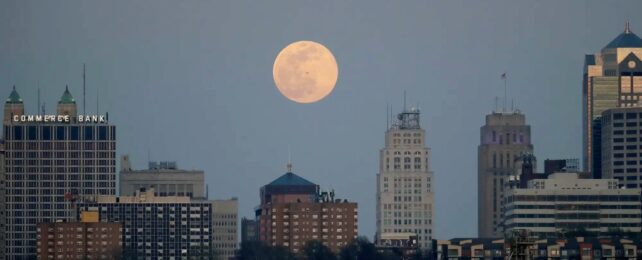On Wednesday, a full, luminous moon will appear in the sky. While experts debate the exact definition of a supermoon, this last full moon of the summer meets all the criteria.
In general, the moon is a supermoon when it reaches the point nearest to Earth in its orbit, known as perigee. At about 226,000 miles from our planet, the moon looks about 7% bigger than a regular full moon, though you may not notice the difference.
But it's a fun astronomical event that even city dwellers can see without going to a dark sky park.
What makes it a blue supermoon?
This supermoon will be about 222,043 miles away, per a retired NASA astrophysicist, Fred Espenak, who calculated supermoon distances through 2100 – making it the brightest moon of the year.
Supermoon is a fairly new word. Astrologer Richard Nolle created the term in 1979 to mean either a new or full moon within 90% of perigee. Full moons are bright, and new moons are rarely visible from Earth. But both affect the tides, making them more extreme than usual.
Similar to Strawberry Moons and Pink Moons, a Blue Moon isn't named for its color. Instead, as the phrase "once in a blue moon" suggests, it's all about timing. On Wednesday, it will be the second full moon of the month. The first was on August 1.
While the current qualification for a Blue Moon is the second full moon to occur in a month, an older definition used the number of full moons in a year. Usually, there were 12, but sometimes there would be an extra one. Some publications, like the "Maine Farmers' Almanac," measured the year differently, starting in late December instead, according to the Library of Congress.
Sky & Telescope magazine published the newer two-in-a-month definition in the 1940s, and Deborah Byrd helped popularize the definition on the science radio show StarDate in 1980.
How rare is a Blue Supermoon?
Supermoons aren't rare in and of themselves. There are typically three or four a year.
Blue Moons are less common: Only one in about 33 moons qualifies. Both happening at once occurs every 10 to 20 years. The next blue supermoon will rise in 2037, according to NASA.
The moon actually appearing blue is an exceedingly unusual but plausible event.
In 1883, Krakatau's deadly volcanic eruption killed 36,000 people. Sulfur dioxide and ash filled the air, making the moon look blue as the particles blocked red light without filtering other hues. Forest fires can cause the same effect, according to London's Natural History Museum.
This article was originally published by Business Insider.
More from Business Insider: